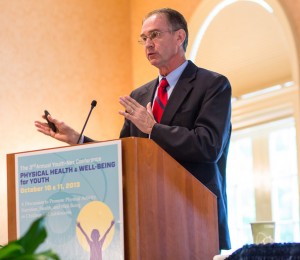The annual Youth-Nex Conference on Physical Health & Well-Being, was held October 11 & 12, 2013 at the University of Virginia.
The following is a summary of the presentation by Russell Pate, Ph.D., by Jeanette Garcia, graduate student in the Curry School of Education’s Department of Kinesiology, under the direction of Art Weltman, Ph.D., conference chair. Video also available here.
Russell Pate, Ph.D., is Professor and Director, Children’s Physical Activity Research Group, University of South Carolina Arnold School of Public Health. He is also the current president of the National Physical Activity Plan Alliance. His research interests include physical activity and physical fitness in children and the health implications of physical activity.
There is evidence that the following strategies are effective:
- Multi-component school interventions
- Physical education in school
There is evidence that the following strategies are emerging or suggestive:
- Activity breaks in school
- Pre-school and childcare settings
Community and built environment
The following strategies have insufficient evidence at this time:
- School physical environment and after-school
- Camps, youth organizations, and other programs in the community
- Family and home
- Primary care settings
Current Physical Activity Guidelines for Adolescents and Youths
> Children should do 60 minutes or more of physical activity daily, including:
- Aerobic-moderate to vigorous intensity, 3/week
- Muscle-strengthening exercise, 3/week
- Bone-strengthening exercise, 3/week
Did you know: “For 25 years, we’ve had federally mandated dietary guidelines, but there were no physical activity guidelines. They were finally mandated in 2008.” – Russ Pate
Overheard: “I had no idea there weren’t any federally mandated guidelines for physical activity! I just assumed they always were in place. ” – A 4th year Kinesiology student at the panel
Physical Activity Guidelines for Young Children
Toddlers and preschoolers should be provided with “opportunities for light, moderate, and vigorous physical activity for at least 15 minutes per hour while children are in care.” This is equal to 3 hours of physical activity over a period of 12 waking hours. – IOM Physical Activity Guideline
Health Benefits of Physical Activity (Based on evidence from the literature)
- Lower Body Fatness
– Gutin et al. Am J Clin Nutr 2002; 75: 818-826
- Favorable Cardiovascular & Metabolic Disease Risk Profiles
– Andersen et al. Lancet 2006; 368: 299-304
- Higher Cardiorespiratory Fitness
– Baquet et al. Sports Med 2003; 33: 1127-1143
- Increased Muscular Strength
– Malina RM. Clin J Sports Med 2006; 16: 478-487
- Increased Bone Density
– Arnett & Lutz. Med Sci Sports Exerc 2002; 34: 1913-1919
- Reduced Symptoms of Depression
– Motl et al. Psychosom Med 2004; 66: 336-342
The Limitations: What we still don’t know.
- Little evidence in children under 6 years of age
- Influence on weight status poorly understood
- Dose-response – little known for most outcomes
- Design limitations – few prospective longitudinal studies & large scale clinical trials
Related posts: Conference on Physical Health & Well-Being, Health, Research, Conferences

